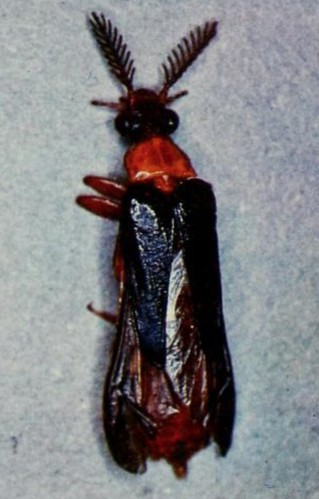After spending some time trying to figure out this observation, I spent a little more time this weekend understanding its Californian cousin Zarhipis, and I wanted to jot down some notes.
Identification
The best and most recent identification resource I've found is
Linsdale, Donald D. (1964). A Revision of the Genus Zarhipis LeConte (Coleoptera: Phengodidae)". The Wasmann Journal of Biology. 22 (2): 225–260.
According to Linsdale, we have three species of banded glowworm in California (Genus Zarhipis):
| Image |
Name |
Distribution |
Type Specimen |
ID Notes |
 |
Zarhipis integripennis |
WA-BJS, east to AZ, generally below 6000 ft. |
MCZ Type No. 2809
|
Varied sizes and colors, but elytra rounded and cover > 1/2 of the wings, not tapered. |

Note that this obs. shows the tapering elytra a lot better.
|
Zarhipis truncaticeps |
SoCal through southern AZ, with a disjunct population in Otero County, NM |
MCZ Type No. 24156
|
Elytra extend over > 1/2 the wings, but taper toward the ends so their width doesn't cover all the wings the length does |

Photo from Tiemann (1967), (c) California Academy of Sciences, licensing status unknown, but since I work at the Academy and this website is owned and operated by the Academy, I'm going to assume it's ok.
|
Zarhipis tiemanni |
Mojave Desert from Ridgecrest, CA east to Littlefield, AZ. |
At the Smithsonian, but no photos digitized. |
Elytra tapered as in truncaticeps but shorter, ~1/2 wing length. |
There are several other species of phengodids that are or may be in CA according to the California Beetle Project, but all are smaller than 10 mm as adult males according to the key on p. 184 of Arnett et al.'s American Beetles, Volume II, which you can find with the search excerpts on Google Books. They are
-
Cenophengus debilis LeConte
-
Cenophengus longicollis Wittmer
-
Distremocephalus californicus (Van Dyke)
-
Distremocephalus opaculus (Horn)
-
Paraptorthodius mirabilis Schaeffer
-
Phengodes bella Barber
There are also at least two lampyrids, Pterotus obscuripennis and Pterotus curticornis, that you might confuse with Zarhipis b/c they're big, have orange and black coloration, and males have plumose antennae, but note that in both the "branches" on the antennae only come from one side, not both as in Zarhipis.
There is also an excellent illustration of all three species on p. 231 of Linsdale, as well as photos of all three on Plate 4 of Tiemann (1967). Linsdale basically took a lot of names and lumped them into the (now) very morphologically diverse Z. integripennis. His justification for doing so was wonderfully dry:
Fortunately Barber left determined and labeled specimens in the U.S. National Museum representing all ten of the forms that he recognized. All of these forms should be included in the highly variable species, Z. integripennis. Examination of the specimens determined by Barber shows that all but one of the forms occur in the San Francisco Bay region of California and that six out of the ten forms occur in Berkeley, Alameda County, California.
On May 29, 1958, one female attracted five males at Danville, Contra Costa County, California, that seemed to represent the following "species": Z. integripennis, Z. piciventris, Z. amictus, and Z. alamedae.
The six "species" that are being placed in synonymy under Z. integripennis were described from a total of ten specimens. When Barber proposed his ten forms, he had studied only 59 specimens. During the course of this study, 938 specimens of Z. integripennis have been examined. The study of this many specimens has convinced me that the characters used in the past (the color of the dorsal surface of the head and the ventral surface of the abdomen and the width of the border of the pronotum) are variable and unreliable for the separation of the species in the genus Zarhipis.
Life History
Tiemann (1967) is an excellent study of the life history of Z. integripennis with lots of great info and photos. I found notable that
- Larvae glow the most when resting, the least when actively hunting
- Mature larviform females would not eat in captivity
- Larvae are most active when their millipede prey are most active, i.e. when it's damp (not when you usually see the males flying in the warmer summer months)
- Multiple larvae will feed on a single millipede at once
- Tiemann described the feeding behavior to be so consistent as to be "programmed": they would bite between the head segment and the first body segment and presumably sever a nerve b/c the milliped would stop moving, sever the rest of the head, eat it, then crawl through the rest of the body, and clean everything out. Tiemann speculated that they exude digestive enzymes because all that remains are the hardened exoskeleton segments.









